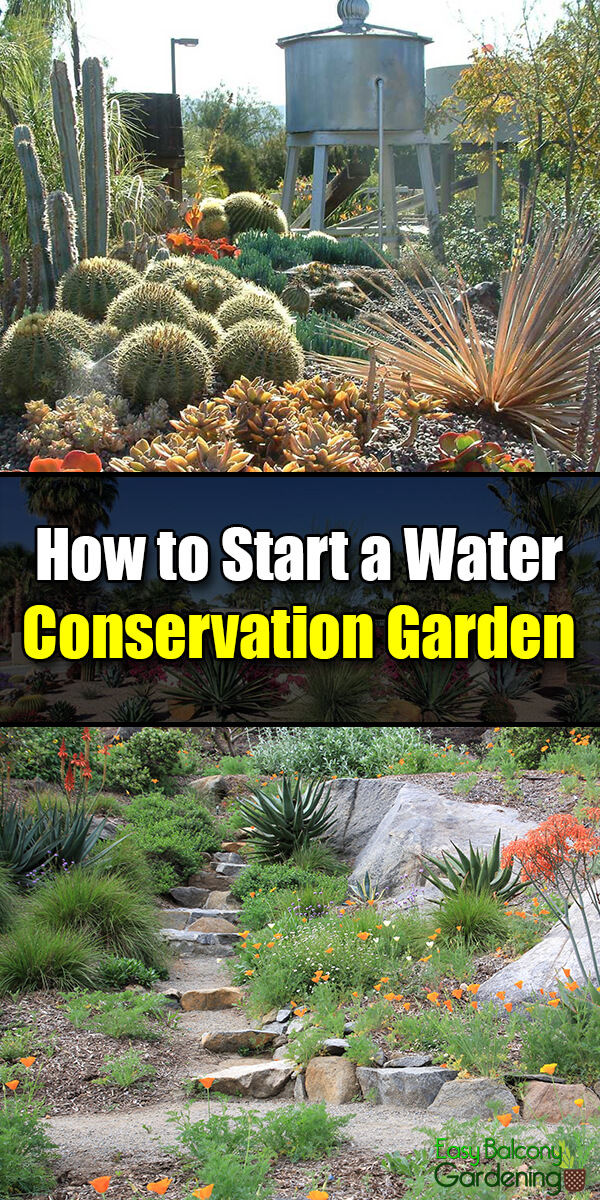A water conservation garden helps us all toward improving our economy. Everyone can conserve water, and we must do our best to do so.
Container Plants
- As important as keeping your plants healthy by not over irrigating is the water you conserve by watering properly. A water conservation garden is also for container plants. Container plants usually need frequent watering, and the right containers help.
- If you are for a water conservation garden, carefully choose your containers. Although terra cotta can be quite attractive, it draws moisture from the soil. Metal and plastic as well as larger pots and wood planters retain moisture longer
- It is a good investment, when you want a water conservation garden, to have a moisture meter. It will tell you when to water. Absent one, stick your index finger in the soil. If it is dry about one-and-one-half inches down, water. If damp, do not water
- Another option toward a water conservation garden is self-watering pots, drip irrigation systems, or slow-release irrigation supplements. The latter comes in a package. You can either put it on the surface or bury by the plant roots. Your plants will receive a steady moisture supply up to three months.
Mulching
- Through mulching, we can conserve moisture. That is wise management when working toward a water conservation garden.
- Mulching helps your water conservation garden to prevent moisture loss. It also assists with drainage, frozen plant roots, and weed growth. Mulching encourages root growth, makes nutrients more available to plants, and cools the soil during hot weather.
- Mulch can be either organic or inorganic. Examples are wood chips (avoid those from chemical treated lumber), gravel, compost, crushed brick, etc.
- Leave about three inches of clearing from the plant base, spread around a layer of mulch from one to three inches. Water down the mulch.
- To keep up with your water conservation garden, rake the mulch whenever its color fades. Add more mulch when the layer has thinned that it does not sufficiently block the sun and prevent weeds from growing.
- Mind the mulch thickness when tending your water conservation garden. Too much mulching can also prevent irrigation from getting to the soil.
Zoning
There are usually three water-use zones when considering a water conservation garden. Group plants according to their water requirements.
- High – plants need regular watering in the absence of rainfall
- Moderate – established plants are watered when wilting, changing color, and other signs of moisture stress. Some examples are azaleas, Japanese maple, etc.
- Low – plants that can survive just on natural rainfall. Observe what native plants in your area have adjusted to weather conditions.
- Having a water conservation garden means knowing your garden better. Be aware where the shady areas are, where the soil drains well, flat areas, etc. Choose plants in accordance with microclimates.
Sound Logic
- A water conservation garden means a correct irrigation system. Do not rely on a fixed watering schedule. Plants’ water needs depend on humidity, temperature, soil, mulching, etc. Take time to adjust controls and timers as needed.
- Another sound logic for a water conservation garden is developing your soil. For established garden, improve the soil retention quality through regular mulching. For new gardens, conserve water by mixing about two inches of organic compost in the top seven or eight inches of the soil.
- Drip irrigation systems, tap timers, etc. assist in a successful water conservation garden
- Watering cans help water go to the plant roots where it is needed
- Trees have roots that extend from the trunk to receive their nutrients. Water them around the outside instead of at the base.
- A hose can make watering easier, but it can cause too light or too frequent irrigation. A water conservation garden requires your knowledge that not all plants do well with hand-held hoses
Recap
- Keep up with the mulch
- Gradually improve the organic content of your soil
- Water as necessary, and be observant
A water conservation garden is within your reach!







